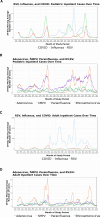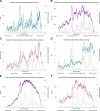The Recent Increase in Invasive Bacterial Infections: A Report From the National COVID Cohort Collaborative
- PMID: 39951364
- PMCID: PMC11812670
- DOI: 10.1097/INF.0000000000004575
The Recent Increase in Invasive Bacterial Infections: A Report From the National COVID Cohort Collaborative
Abstract
Background: When coronavirus disease 2019 (COVID-19) mitigation efforts waned, viral respiratory infections (VRIs) surged, potentially increasing the risk of postviral invasive bacterial infections (IBIs). We sought to evaluate the change in epidemiology and relationships between specific VRIs and IBIs [complicated pneumonia, complicated sinusitis and invasive group A streptococcus (iGAS)] over time using the National COVID Cohort Collaborative (N3C) dataset.
Methods: We performed a secondary analysis of all prospectively collected pediatric (<19 years old) and adult encounters at 58 N3C institutions, stratified by era: pre-pandemic (January 1, 2018, to February 28, 2020) versus pandemic (March 1, 2020, to June 1, 2023). We compared the characteristics and outcomes of patients with prespecified VRIs and IBIs, including correlation between VRI cases and subsequent IBI cases.
Results: We identified 965,777 pediatric and 9,336,737 adult hospitalizations. Compared with pre-pandemic, pandemic-era children demonstrated higher mean monthly cases of adenovirus (121 vs. 79.1), iGAS (5.8 vs. 3.3), complicated pneumonia (282 vs. 178) and complicated sinusitis (29.8 vs. 16.3), P < 0.005 for all. Among pandemic-era children, peak correlation between RSV cases and subsequent complicated sinusitis cases occurred with a 60-day lag (correlation coefficient 0.56, 95% confidence interval: 0.52-0.59, P < 0.001) while peak correlation between influenza and complicated sinusitis occurred with a 33-day lag (0.55, 0.51-0.58, P < 0.001). Correlation among other VRI-IBI pairs was modest during the pandemic and often lower than during the pre-pandemic era.
Conclusions: Since COVID-19 emerged, mean monthly cases of iGAS, complicated pneumonia, and complicated sinusitis have been higher. Pandemic-era RSV and influenza cases were correlated with subsequent cases of complicated sinusitis in children. However, many other VRI-IBI correlations decreased during the pandemic.
Copyright © 2024 The Author(s). Published by Wolters Kluwer Health, Inc.
Conflict of interest statement
The authors have no conflicts of interest to disclose.
Figures



Similar articles
-
Invasive group A streptococcal infections as a consequence of coexisting or previous viral infection in the post-COVID-19 pandemic period.J Infect Public Health. 2025 Jan;18(1):102622. doi: 10.1016/j.jiph.2024.102622. Epub 2024 Dec 16. J Infect Public Health. 2025. PMID: 39708759
-
Post-pandemic increase in invasive group A strep infections in New Zealand.J Infect Public Health. 2024 Nov;17(11):102545. doi: 10.1016/j.jiph.2024.102545. Epub 2024 Sep 17. J Infect Public Health. 2024. PMID: 39303459
-
Attribution of invasive group A streptococcal infections (iGAS) to predisposing viral infections, the Netherlands, 2010 to 2023.Euro Surveill. 2024 Oct;29(40):2300739. doi: 10.2807/1560-7917.ES.2024.29.40.2300739. Euro Surveill. 2024. PMID: 39364598 Free PMC article.
-
Invasive Group A Streptococcal Infections in Europe After the COVID-19 Pandemic.Dtsch Arztebl Int. 2024 Oct 4;121(20):673-680. doi: 10.3238/arztebl.m2024.0127. Dtsch Arztebl Int. 2024. PMID: 38961826 Free PMC article. Review.
-
Increased incidence of intracranial complications following pediatric sinogenic and otogenic infections in the post-COVID-19 Era: A systematic review and meta-analysis.Int J Pediatr Otorhinolaryngol. 2025 Jun;193:112364. doi: 10.1016/j.ijporl.2025.112364. Epub 2025 Apr 22. Int J Pediatr Otorhinolaryngol. 2025. PMID: 40279858
References
MeSH terms
Grants and funding
LinkOut - more resources
Full Text Sources
Medical

